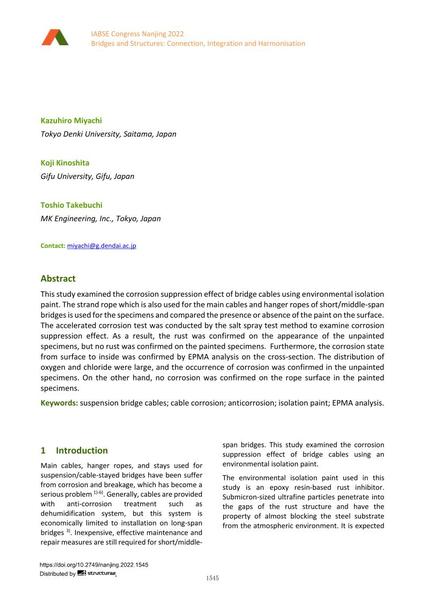Corrosion Suppression Effect of Bridge Cables Using Environmental Isolation Paint

|
|
|||||||||||
Bibliographic Details
| Author(s): |
Kazuhiro Miyachi
(Tokyo Denki University, Saitama, Japan)
Koji Kinoshita (Gifu University, Gifu, Japan) Toshio Takebuchi (MK Engineering, Inc., Tokyo, Japan) |
||||
|---|---|---|---|---|---|
| Medium: | conference paper | ||||
| Language(s): | English | ||||
| Conference: | IABSE Congress: Bridges and Structures: Connection, Integration and Harmonisation, Nanjing, People's Republic of China, 21-23 September 2022 | ||||
| Published in: | IABSE Congress Nanjing 2022 | ||||
|
|||||
| Page(s): | 1545-1550 | ||||
| Total no. of pages: | 6 | ||||
| DOI: | 10.2749/nanjing.2022.1545 | ||||
| Abstract: |
This study examined the corrosion suppression effect of bridge cables using environmental isolation paint. The strand rope which is also used for the main cables and hanger ropes of short/middle-span bridges is used for the specimens and compared the presence or absence of the paint on the surface. The accelerated corrosion test was conducted by the salt spray test method to examine corrosion suppression effect. As a result, the rust was confirmed on the appearance of the unpainted specimens, but no rust was confirmed on the painted specimens. Furthermore, the corrosion state from surface to inside was confirmed by EPMA analysis on the cross-section. The distribution of oxygen and chloride were large, and the occurrence of corrosion was confirmed in the unpainted specimens. On the other hand, no corrosion was confirmed on the rope surface in the painted specimens. |
||||
| Keywords: |
anticorrosion cable corrosion suspension bridge cables isolation paint EPMA analysis
|
||||
| Copyright: | © 2022 International Association for Bridge and Structural Engineering (IABSE) | ||||
| License: | This creative work is copyrighted material and may not be used without explicit approval by the author and/or copyright owner. |
||||
